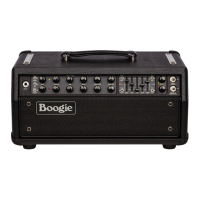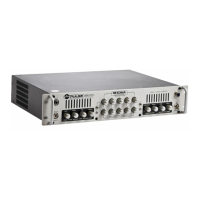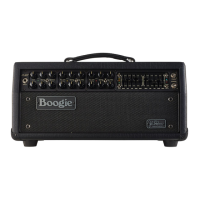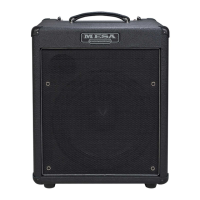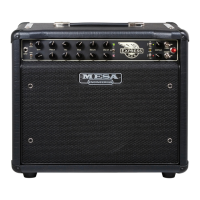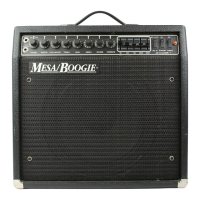PAGE 34
result in damage to your amplifier not covered under its Warranty.
MIDI IN
This DIN jack accepts a 5-Pin DIN connector and is the input for MIDI signals generated by your MIDI control-
ler that you may want to use to control your amplifier. It can also be used to connect multiple MARK VIIs and
control them via one “Master” MARK VII. See the section regarding Controlling multiple Mark VIIs in the MIDI
Implementation section later in this manual.
MIDI THRU/OUT
This 5-Pin DIN jack sends and forwards MIDI information generated (like a Preset Dump) or received via external
sources (like a foot controller or a Sequencer). If performing a Preset Dump from one Mark VII (using the MIDI
THRU/OUT to another (using the MIDI IN), make sure both amplifiers are set to the same MIDI Channel via the
MIDI CHAN rotary select.
STORE
This mini toggle activates the STORE function so that your choices of Channels (with their Modes already
selected within) and Switchable Features, such as Reverb, EQ, and CabClone Cabinet IRs, can be stored and
called up repeatedly under MIDI Program Change messages.
MIDI CHAN
This 16-position rotary selector allows you to set the MIDI Channel on which the MARK VII will respond to MIDI
Program Change and Control Change Messages. The MIDI foot controller in use must be set to send mes-
sages on the same MIDI Channel selected here on this rotary selector for the MIDI messages to be received
and interpreted by the MARK VII.
BIAS SWITCH
This switch determines what type of Bias Setting is operational, the standard 6L6 harness or one specifically
adapted to operate EL34s safely. ALWAYS MAKE SURE the Bias Switch is set to match the tubes in use.
We feel the stock 6L6 complement does the best overall job of showcasing the MARK VII’s many dierent
sounds and the musical landscapes the amplifier can cover. That said, there are enhancements in certain areas
possible when the Brit classic EL34 power tubes are substituted. Again, when swapping, ALWAYS MAKE SURE
the Bias Switch is set to match the tubes in use.
The 6L6s will produce a more shimmering top end, robust midrange with body, and low-end depth and girth
that has “air.” This set of traits is balanced and musical and produces great sounds across the gain spectrum.
Whether it’s bubbly, shimmering Cleans to tight, percussive Crunch Rhythm sounds to soaring vocal solo
sounds, or huge grinding Metal sounds, 6L6s serve it all up and with finesse. These sonic features, along with
its robust construction and rugged reliability, make it our long-standing choice for the Stock complement of
tubes in production.
Conversely, EL34s will strip sub-lows and skinny-up the bottom end, scoop the lower Midrange, and add slic-
ing, shredding cut to the upper Mids while enhancing the higher harmonics as well. These traits are even
more apparent when overdrive is in use. When pushed to clip in the lower wattage Multi-Watt options, these
characteristics will serve you well for classic and indie rock and nu country styles or anywhere a Brit-influenced,
urgent character is desired.
NOTE: Historically, we have seen the 6L6 to be a more rugged and reliable power tube in comparison to the EL34. If you
prefer the EL34 sonically, may we humbly suggest keeping a small stock of extra power tubes (in pairs) on hand and some
extra Fuses of the same type and rating in your gig bag. This is wise regardless of the power tube type you favor, especially
if you perform frequently, but even more so when EL34s are your tube of choice.
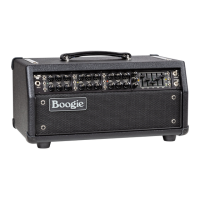
